“I used to love using Medium, but now that I have an audience, I want to branch out and monetize my content.”
Sound familiar? Here at WPBeginner, we’re committed to helping content creators like you break free from the platforms that are holding you back.
More than that, we’re here to guide you toward a platform that gives you complete control over your content and how you monetize it. We’re talking about WordPress!
In this step-by-step guide, we’ll share the exact process we use to help bloggers move from Medium to WordPress. You’ll learn how to transfer your content safely, keep your readers, and set up your new WordPress site for long-term success.
Whether you have a handful of Medium posts or hundreds of articles, we’ll show you how to make the transition smooth and successful.
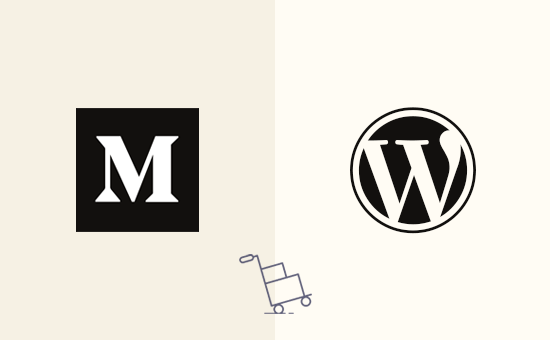
Why You Should Move from Medium to WordPress?
If you’re serious about your content, you’re probably looking for a platform with more power and control than Medium offers. That’s where WordPress comes in.
WordPress is the most popular website builder in the world, powering more than 43% of all websites on the internet.
And it’s not just popular; this content management and blogging platform is also incredibly user-friendly, super powerful, and easy to customize.
Want to really dig into what WordPress can do? Check out our complete WordPress review, where we break down all the pros and cons.
Now, when we say WordPress, we are talking about self-hosted WordPress.org. Not to be confused with WordPress.com, which is a hosted platform.
If you’re not sure about the difference, our article on WordPress.com vs. WordPress.org will clear things up.
While Medium is a good blogging platform for new writers, many users quickly realize that it’s quite limited when compared to WordPress. You don’t have full ownership of your website, and the customization options are pretty basic. Plus, monetizing your content the way you truly want to can be a real challenge on Medium.
On the other hand, WordPress has a massive advantage when it comes to building a website that search engines like. You have the tools to ptimize your on-page SEO, and you can choose from tons of responsive themes and templates to perfectly match your brand and style.
So, if you’ve made the smart decision to migrate your content from Medium to WordPress, congratulations! You’re about to unlock a whole new level of control and potential. To make this transition as smooth as possible, we’ve created this complete step-by-step guide to help you move all your articles and content from Medium over to its new WordPress home.
Bonus Free Offer: Since a lot of users have asked for this, we are now offering a free Medium to WordPress migration service as part of our free WordPress blog setup. This means one of our expert team members will do the entire migration for you (100% free). Yes, you can literally switch from Medium to WordPress without any risk.
However, if you like learning and doing things yourself, then you can follow our step-by-step tutorial below.
Here’s a breakdown of all the steps that we will be covering in this step-by-step tutorial:
Ready? Let’s get started!
Step 1. Install and Setup WordPress
To get started with WordPress, you’ll need the following two things.
- A web hosting account. This is where all your website files are stored.
- A domain name. This will be your website’s address on the internet and what users will type in their browser to reach your website. For example,
wpbeginner.com.
A domain name typically costs around $14.99 per year, and website hosting starts from $7.99 per month.
Thankfully, Bluehost, an official WordPress-recommended hosting provider, has agreed to offer our users a free domain name and over 60% off their web hosting service.
→Click Here to Claim This Exclusive Bluehost Offer ←
If, for some reason, you want other options, then you can look at our list of the best WordPress hosting companies.
Once you have set up your domain and hosting, the next step is to install WordPress.
Most WordPress hosting companies offer 1-click install options that you can use to instantly install WordPress. If you can’t find it, then ask your hosting provider’s support, and they will set it up for you.
You can also do it yourself. For step-by-step instructions, see our complete guide on how to install WordPress.
After you’re done installing WordPress, you’re ready to move on to the next step, which is to export your content from Medium.
Step 2. Exporting Your Data from Medium
Previously, it was quite difficult to export your data from Medium in a WordPress-compatible format.
We decided to solve this problem and developed a Medium to WordPress Importer tool.
It’s a free online tool that imports content from Medium and converts it into a WordPress-compatible export file. It does not change your existing Medium content, so it is perfectly safe to use.
Head over to Medium to WordPress Importer website and enter your Medium blog URL.
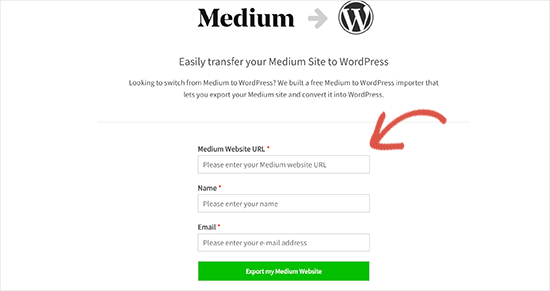
Now, if your Medium blog URL uses a custom domain name and is like http://example.com or https://something.example.com, then enter the URL with your name and email address.
On the other hand, if you don’t have a custom domain name, then the Medium to WordPress Importer will ask you to upload the Medium export file.
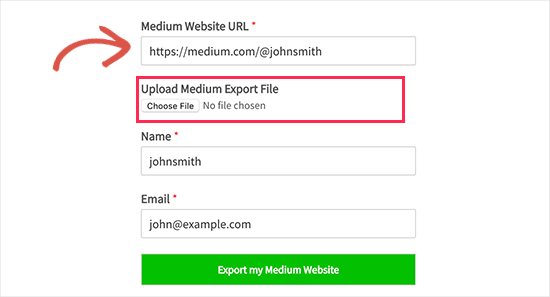
Here is how you can get that export file from Medium.
First, you need to log in to your Medium account and click on your profile photo at the top right corner of the screen. This will bring down the menu. From here, you need to click on the ‘Settings’ link.
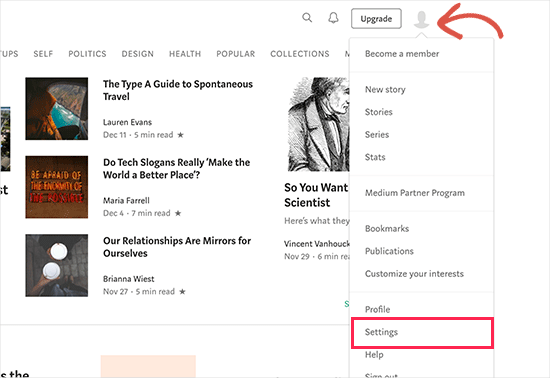
This will take you to the settings page, where you need to scroll down to the ‘Download Your Information’ section.
Go ahead and click the ‘Download zip’ button to export your Medium data.

On the next page, you’ll want to click on the export button. Medium will then prepare your download and send a link to you via email.
You need to check your email to see if you received the email from Medium. Then, you can follow the link in the email to download your Medium export file.
Once you have downloaded the Medium export file, you can switch to the Medium to WordPress Importer tool and upload that file.
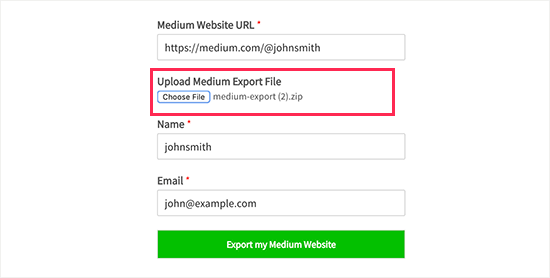
Next, let’s click the ‘Export My Medium Website’ button to continue.
Medium to WordPress Importer will now prepare your export file. Once finished, it will show you a success message with a button to download your WordPress-ready Medium export file.
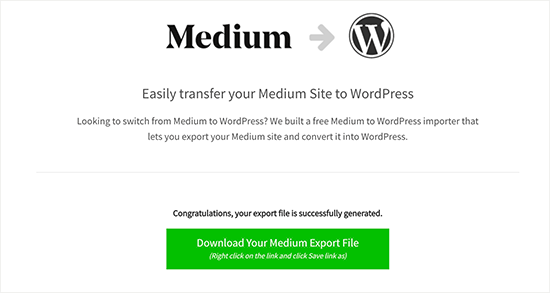
Go ahead and download the export file to your computer. You will need that file in the next step.
Step 3. Importing Your Medium Articles into WordPress
Now that you have successfully exported your Medium content into a WordPress-compatible format, it’s time to import that content into your new WordPress blog.
To get started, you’ll want to visit the WordPress admin area and head over to Tools » Import.
Here, you will see a list of importers available for different platforms. Let’s scroll down to WordPress and click the ‘Install Now’ link.
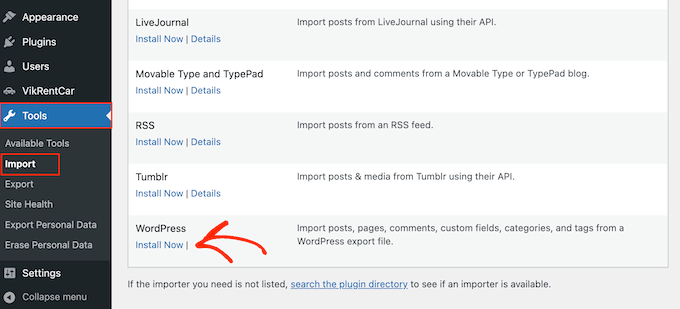
WordPress will then fetch the importer plugin and install it on your WordPress site without reloading the page.
Once installed, you’ll need to click on ‘Run Importer’ to launch it.
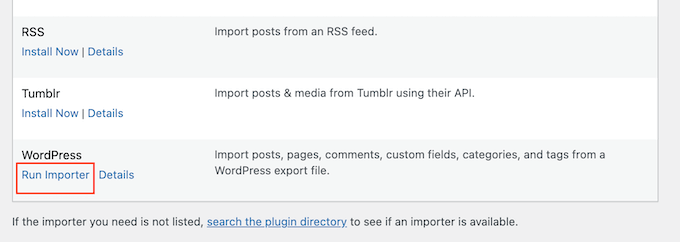
This will bring you to the WordPress importer page. Go ahead and click the ‘Choose file’ button to select the export.xml file you downloaded earlier.
Next, you can go ahead and click the ‘Upload file and import’ button to continue.
WordPress importer will now upload and analyze your Medium export file. On the next screen, it will ask you to assign authors.
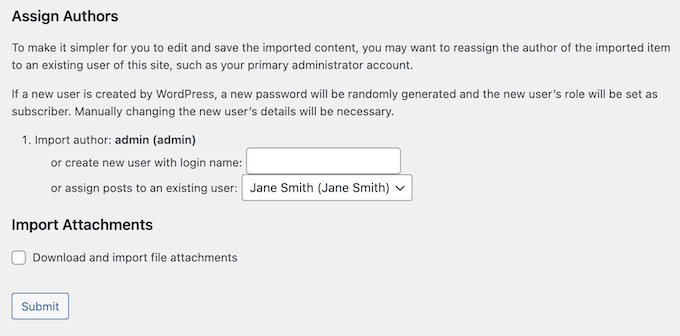
You can import the author from your Medium website, create a new author, or assign all content to your existing WordPress user.
Don’t forget to check the box next to the ‘Download and import file attachments’ option. It will fetch images from your Medium website and put them into your WordPress media library.
With that done, all that’s left to do is click the ‘Submit’ button to run the importer.
WordPress will then import content from the Medium export file. It will also try to fetch images in your Medium articles.
Upon completion, you’ll see a success message.

Congratulations, you have successfully imported content from Medium to WordPress!
You can now go to the posts page in your WordPress admin area to see if all your content is there.
If the import process fails in the middle, then you can always run it again. The importer is smart enough to detect duplicate content and skip it. It will only import the content that wasn’t imported successfully in the previous attempt.
Step 4. Importing Your Images From Medium to WordPress
The WordPress importer tries to import images from your Medium articles to the WordPress media library. However, it may fail due to how Medium displays images in your articles.
To solve this, you’ll first need to go to Media » Library to see all images that have been imported successfully.
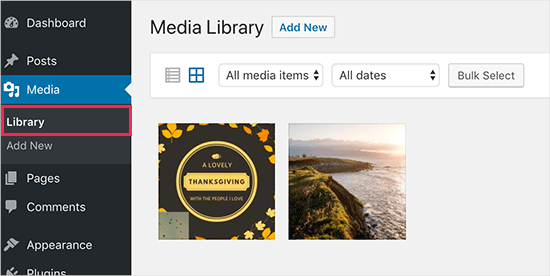
If some or all of your images fail to import, then you will need to upload them again.
To replace broken images across your WordPress site, we recommend using the free Search & Replace Everything plugin by WPCode. This plugin addresses WordPress’s lack of a built-in find-and-replace feature, allowing you to replace outdated images site-wide with just one click.
For more details, you can see our step-by-step guide on how to easily replace image and media files in WordPress.
Note: While the free version works for replacing media files, upgrading to the Search & Replace Everything Pro version offers additional features like undoing changes and replacing images directly in the WordPress block editor.
Alternatively, you can bulk update all articles at once to quickly import all images. For detailed instructions, see our step-by-step tutorial on how to import external images in WordPress.
Step 5. Setting up Redirects
If your Medium stories had a medium.com URL, then you cannot set up redirects.
But if you were using a custom domain for your Medium publication, then you can set up custom redirects in WordPress.
First and foremost, you will need to get all URLs of your Medium articles and save them in a text file. After that, you’ll start setting up redirects for all your articles.
There are multiple ways to set up redirects in WordPress. For detailed instructions, follow our beginner’s guide to creating redirects in WordPress.
Step 6. Installing a WordPress Theme
By default, each WordPress site comes with a basic theme. If you visit your new site, then you’ll see something like this:
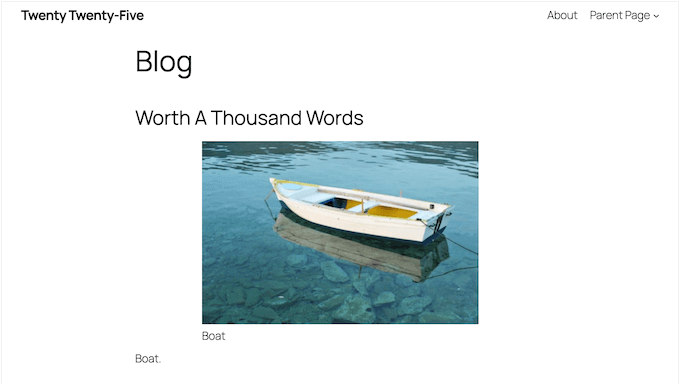
This is a generic WordPress theme with limited features, so you’ll typically want to replace it.
The awesome thing about WordPress is that there are literally thousands of free and premium WordPress themes you can use to completely customize the look and feel of your website. Whether you want a clean and minimalist design to let your writing speak for itself, or something more visually engaging, you’ll find a theme that fits.
To give you a head start, here are our expert recommendations for the best WordPress themes in different categories:
- Best free WordPress blog themes
- Best WordPress themes for writers
- Best WordPress themes for artists
- Best Medium-like WordPress themes
After you have chosen a theme, you can follow our guide on how to install a WordPress theme to set it up.
Another option is using a page builder plugin to design completely custom layouts. Our top pick is SeedProd as it’s incredibly user-friendly, even when you’re completely new to WordPress.
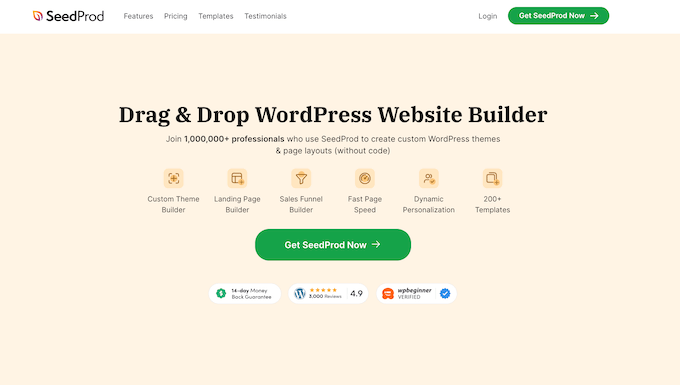
It uses a simple drag-and-drop interface, so you can literally pick elements like text blocks, images, videos, and buttons and arrange them on your page exactly where you want them.
In addition, it has a ton of ready-made templates including magazine-style templates that are perfect for showing off your Medium content.

Intrigued by the idea of having complete creative control over your website’s design now that you’re moving off Medium? Then you need to check out our detailed SeedProd review, where we share more information about this popular page builder.
Step 7. Installing Essential WordPress Plugins
Plugins are like apps for your WordPress blog. They allow you to add new features and extend the functionality of your WordPress site. To learn more, see our article about what are WordPress plugins and how they work.
There are thousands of free and premium WordPress plugins that you can install on your website. At the time of writing this article, the WordPress.org plugin directory alone had more than 59,000 thousand free plugins.
So, how do you know if you need a WordPress plugin? More importantly, how do you find out the best WordPress plugin for the job?
Well, there are some WordPress plugins made for specific websites, such as eCommerce plugins, membership plugins, or LMS plugins.
Then, there are plugins that almost every website needs. Let’s install these plugins on your new WordPress site:
- WPForms Lite – This is the free version of WPForms, which is the best WordPress contact form plugin on the market. It allows you to easily add beautiful forms to your website.
- MonsterInsights Lite – This free version of the popular MonsterInsights plugin helps you install Google Analytics in WordPress. It also shows you beautiful reports about your most popular articles, where your users are coming from, and more.
- All in One SEO – This is the best WordPress SEO plugin on the market. It helps you improve WordPress SEO and get more visitors from search engines.
Need more plugin recommendations? Check out our pick of the essential WordPress plugins every website should have.
Step 8. Learning WordPress
WordPress is quite easy to use. However, as a new user, you may need some help familiarizing yourself with the platform.
This is where WPBeginner can help. We are the #1 WordPress resource site with thousands of tutorials, guides, and videos created specifically for beginners, small businesses, and non-tech users.
Following are some of the helpful resources that you can find from WPBeginner (all of them are completely free).
- WPBeginner Blog – The central place for all our WordPress tutorials and guides.
- WPBeginner Dictionary – Our WordPress glossary is the best place to familiarize yourself with the WordPress lingo
- WPBeginner Videos – New WordPress users can start with these 23 videos to master WordPress.
- WPBeginner on YouTube – Need more video instructions? Subscribe to our YouTube channel with more than 1.03M subscribers and 53+ million views.
- WPBeginner Blueprint – Check out the plugins, tools, and services we use on WPBeginner.
- WPBeginner Deals – Exclusive discounts on WordPress products and services for WPBeginner users.
Video Tutorial
If you are more of a visual learner, you may want to check out our video tutorial:
We hope this article helped you learn how to properly move from Medium to WordPress. You may also want to see our ultimate guide on how to improve your WordPress SEO and our comparison of the best email marketing services.
If you liked this article, then please subscribe to our YouTube Channel for WordPress video tutorials. You can also find us on Twitter and Facebook.





Dennis Muthomi
What about the potential duplicate content issues that could arise?
Because now there is content on meduim that is already cached by Google and now the content on WordPress.
WPBeginner Support
Setting up redirects handles the concerns with duplicate content.
Admin
Dennis Muthomi
Thank you for that suggestion on using redirects, I think I was abit confused there but THANKS!
Mark
Super helpful… worked like a charm! I’m curious what the appropriate etiquette for my previous medium site is. I was on a free account. Do I pull down the original articles? I don’t want to be negatively impacted by Google for having duplicate content without properly attributing Medium (even though it would be my own content). Any advice here? Thanks!
WPBeginner Support
We would recommend having a post to let your visitors know of your new site location, then you would unpublish the old articles to prevent any duplicate content concerns.
Admin
Sunny
Hi there,
I tried using the mediumtowp tool, but it’s giving me a “this is a very big zip file” error.
WPBeginner Support
For issues like that, please reach out to us using our contact form and let us know the URL of your site.
Admin
Robin
Thanks for the article, I have all the posts migrated to WordPress how do I add 301 redirect so the traffic starts to redirect to the WP blog now and not go to a 404 page?
WPBeginner Support
You would want to take a look at step 5 in this guide for how to set up the redirects
Admin
Ishaka, mohammed b.
Thank you for the article. It’s been helpful. However, I have an article in medium that enjoys traffic from another site on referral, my concern is: how can that continue if that same write is exported to wordPress considering that the referral link was to medium?
Thanks.
WPBeginner Support
That would be what the redirects are for as long as you had a custom domain.
Admin
Prajyot Kumbharjuvekar
Can we simultaneously post the same article on both the platforms?
WPBeginner Support
While you are able to, Google will likely see that as duplicate content which can affect your SEO
Admin
Phil
There doesn’t seem to be a medium.rss file in the .zip file. How should I import the HTML stories now?
Jakub
I ran into the same issue…
Adam Williams
I have followed these steps but I fall at the final hurdle. I get an error message in wordpress “File is empty. Please upload something more substantial. This error could also be caused by uploads being disabled in you rphp.ini or by post_max_size being defined as smaller than upload_max_filesize in php.ini. I’ve spoken to wpengine and they confirmed that this is not the case with regards to the server side stuff and they couldn’t help troubleshoot the issue. I can find nothing else online to help me get these posts in, so am stuck. Would buy anyone that can help me sort this a crate of beer!
Jaki Levy
This is particularly useful, considering Medium’s announcement today to lay off 1/3 of its staff.
Rich Will
Hi
It would be useful to know how to do this now that the menu has changed.
Thanks!
Camille
Thank you for this tutorial. It seems like the WP menu has changed a bit since you wrote it but I still managed to find what I needed and do the import. I feel so free!!
WPBeginner Support
Hi Camille, we are glad you found it helpful don’t forget to join us on Twitter for more WordPress tips and tutorials.
don’t forget to join us on Twitter for more WordPress tips and tutorials.
Admin